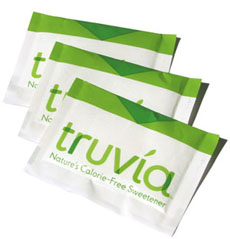Glossary Of Natural & Artificial Non-Caloric SweetenersPage 11: Glossary Of Artificial Sweeteners T To Z This is Page 11 of an 11-page article. Click on the red links below to visit other pages. This glossary is protected by copyright and cannot be reproduced in whole or part. You are welcome to link to it.
|
 Truvia, made from the stevia plant, is a natural sweetner. Photo courtesy The Truvia Company. |
|
|
An asterisk (*) indicates a natural product, i.e., one derived principally from a plant or other natural product.
|
||
|
TAGATOSE* A new entry, tagatose is a low-calorie sweetener derived from lactose, which occurs naturally in some dairy products and other foods. It is very similar in shape and texture to sucrose (table sugar) and is 92% as sweet, but with only 38% of the calories. Since it is metabolized differently from sucrose, tagatose has a minimal effect on blood glucose and insulin levels. In the mid-1990’s tagatose was been approved by the FDA use in foods and beverages; in 2003, Arla Foods began to sell tagatose to food and beverage manufacturers under the brand name Gaio-Tagatose. The sugar was introduced into 7-Eleven’s Diet Pepsi Slurpee and into diet fruit juices sold at Wal-Mart and other chains. Other prominent food product companies are working with it in cereal, chewing gum, chocolate candy, confectioneries, health bars, ice cream, frosting and other products. See also Naturlose.
|
 Tagatose is already used as a low-calorie sweetener in Europe. |
|
|
TRUVIA* Pronounced tru-VEE-ya, Coca-Cola’s branded, zero-calorie sweetener made from rebiana, a compound found in the leaves of the the stevia plant. Pepsi has created a rebiana-based sweetener called PureVia. Both are natural, not chemical, sweeteners.
|
 Truvia can be purchased online. |
|
|
XYLITOL* A natural (nutritive) sweetener derived from fruits and vegetables (e.g. birch bark, plums and corn cob). A sugar alcohol, pure xylitol is a white, crystalline, natural substance that looks and tastes like sugar. Its sweetness is equal to sugar, but it contains 40% fewer calories. It does not require insulin to be metabolized, so it can be used by diabetics. It reduces tooth decay, has been endorsed by dental associations, and is used extensively in sugar-free chewing gums and hard candies. ZERO-CALORIE SWEETENER* See erythritol.
Go To First Glossary Page: Glossary Terms Beginning With A Go To Beginning Of Article On Sweeteners
|

|
|
Last Updated Jun 2018
© Copyright 2005-2025 Lifestyle Direct, Inc. All rights reserved. All images are copyrighted to their respective owners.